Need content ideas that people actually want to know about?
If you want to get lots of people to pay attention to your content, your courses, your opt-in incentives, your social media, live broadcasts, and your podcast episodes, one of the keys is for you to start with content ideas that people are actually interested in knowing about.
I know this sounds totally obvious. But way too many people don’t seem to get this. It’s always sad to look at the work that someone obviously spent hours working on and realize that nobody wants to know about or cares about the thing they just created that content about.
In this article, I’m going to show you two powerful tools that will give you hundreds of proven content ideas for topics that people are actively searching for right now.
And what if I told you that both of those content ideas tools came at my favorite price – free? And when I say free, I mean totally free – these tools never limit you to 30 uses until you have to buy something, nor will they restrict the number of results they’ll give you if your’re not a paying member.
Interested? What are these content idea tools?
Here’s a video that shows the tools and how to use them to help you find content ideas.
The first is a tool you may have just used a few times in the past – Google.
Precisely, it’s a feature in Google called auto-complete.
Try this. Call up Google and start typing something in the search bar. What you’ll find is that as you type, you’ll see a bunch of phrases using the text you’ve already typed as the beginning then giving you suggestions of how you might want to finish it like this:
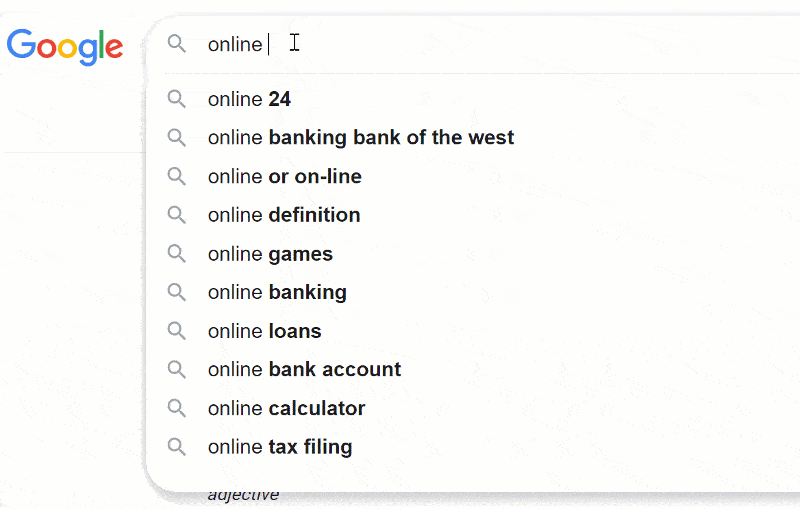
This feature is called autocomplete. Google does it primarily to help people who are searching on mobile, who don’t type quickly, and who make spelling mistakes. (Care to guess which two of those categories I fit into? 🙂 )
But the cool thing for those of us interested in marketing is that this list of content ideas gives us a glimpse into what people are actually searching for online. (We assume that Google populates this list with terms that are frequently searched for on that subject.)
So, if I wanted to create a piece of content about online marketing (which is a very generic term), typing in that phrase would give me a number of more specific keywords related to that topic. In this case online marketing services, degree, course, jobs, classes, etc.
This data tells us that if we were interested in writing something about online marketing, that there are people who are interested in going beyond just the core topic of online marketing, and want to know more about online marketing services, and online marketing degree, all the way down to online marketing strategies.
Google, with its billions of searches per day is telling you that these are topics you may want to create content around because people are interested in them!
In other words, these are proven content ideas you can use as fodder for your content marketing strategies.
By the way, there’s value in doing this exercise regularly. For example, when I shot the video on this page, about a month ago, online marketing tools came up in the list as one of the top ten terms people search for around online marketing. It’s not there now. Needs and searches change across time, giving you even more opportunities to create content people are really wanting, right now!
How to tell if people aren’t searching for your term
The one disadvantage of this service is that whatever you type in the search box is eventually going to show up, no matter how infrequently people search for it. So it’s just as important to know how to use it to identify that the subject you are thinking of is not being actively searched for as knowing that it is.
Let me give you an example. I once had a client call me telling me he wanted me to drop everything because he was going to totally shift his focus from what he was doing to the hottest sub-topic in the marketplace right now. The one everybody’s talking about and focusing on right now.
I immediately called up one of the paid tools I’ll tell you about in a bit and keyed his hot topic, and found that in the last month, everyone in the world had searched for this hot topic a grand total of 6 times.
Both he and I were very glad I did that exercise – it saved him a bunch of money and the time he would have wasted pursuing something that nobody is actually interested in knowing about.
Here’s an easy way to see if people are not searching for your term. Start typing your key phrase. If the term you’re thinking about talking about hasn’t appeared by the time you’ve typed in several letters of the last word, that’s a good indication that either people aren’t searching for that term, or there are at least 10 terms using those letters that people are searching for more frequently than the one you’re thinking of.
Here’s an example using the phrase “online marketing aardvarks” (because everyone knows that there is a large contingent of aardvarks who are well known for their marketing skills.)

Well, maybe not everyone is actively searching for those amazing aardvarks. 🙂
Digging Down To Find Additional Content Ideas
Let’s take this another step further to find additional content ideas.
As you saw, Google updates the list of suggested terms each time you type another letter. If you think about it, that’s a great way to find out other terms related to your core topic that people search on.
Terms you may have not even considered. Terms that can also be excellent content ideas for your digital marketing.
So how about if we type in an a after online marketing, (“online marketing a”) and see what happens?
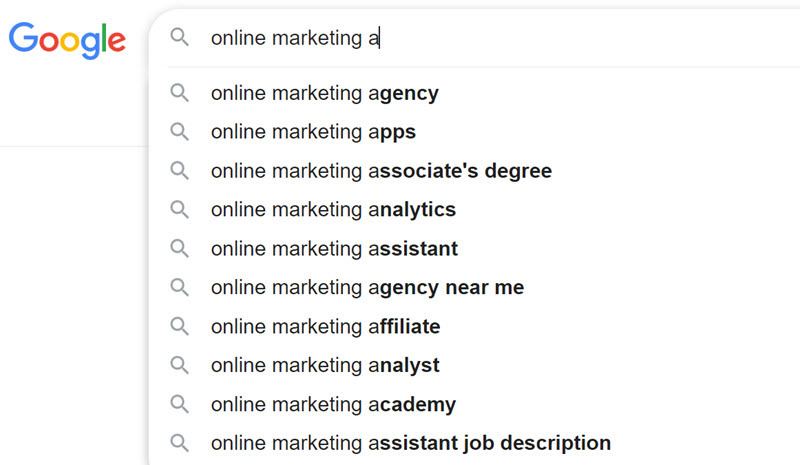
Well, isn’t that interesting. Ten terms related to online marketing that start with the letter a.
I bet you can guess what happens when we replace that a with a b…
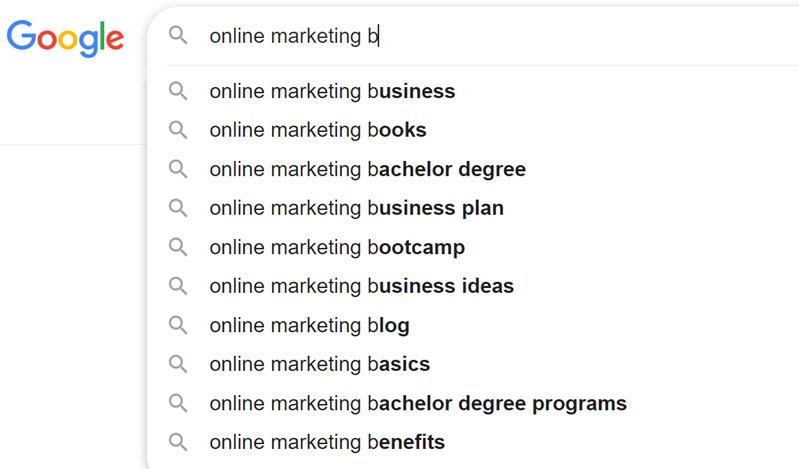
26 letters later, we’ve now got 260 different terms, actively being searched on Google, that are related to our topic area. My guess? There’s at least 50 of those you could create content about!
That should keep you busy for a few days.
Digging Even Deeper Into The Results – Even More Content Ideas
But don’t stop there. Other opportunities are available, and if you just dig deeper you could strike a whole vein of untapped gold….
Let’s imagine that as you proceed down the alphabet and get to the letter “t” you notice a duplicate:

Hmm, tools is in there twice, with more words following it the second time. What would happen if we entered “online marketing tools” into Google to see what would autocomplete:
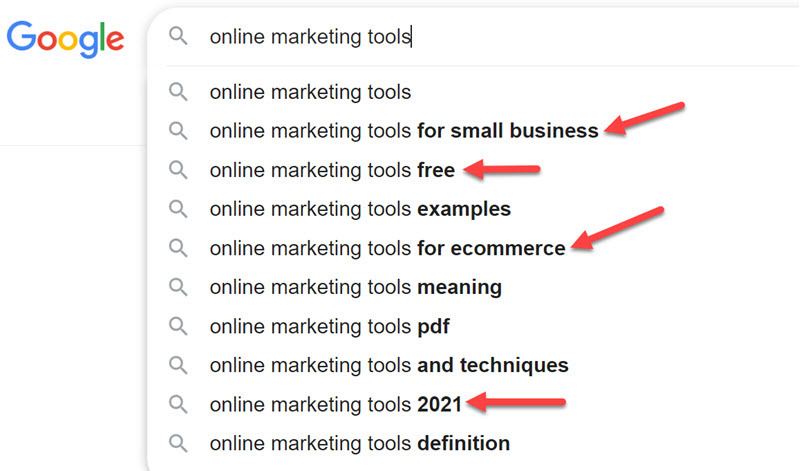
I can see four killer pieces of content in that list, each different than the others, and each something that at least a portion of the audience of people looking to learn more about online marketing would be very interested in.
I guarantee that in that list of 260 (10 for each letter of the alphabet) there are probably 50 terms where the process of digging deeper would yield some very interesting content results.
Some will appear as duplicates (like the tools example I just showed you,) others will be the result of logically looking at the list and asking yourself which terms could be deeper than what you’re seeing here.
Use This Technique To Generate Content Ideas From Other Sites
I bet you can already see where I’m going next.
This same technique works on Youtube:
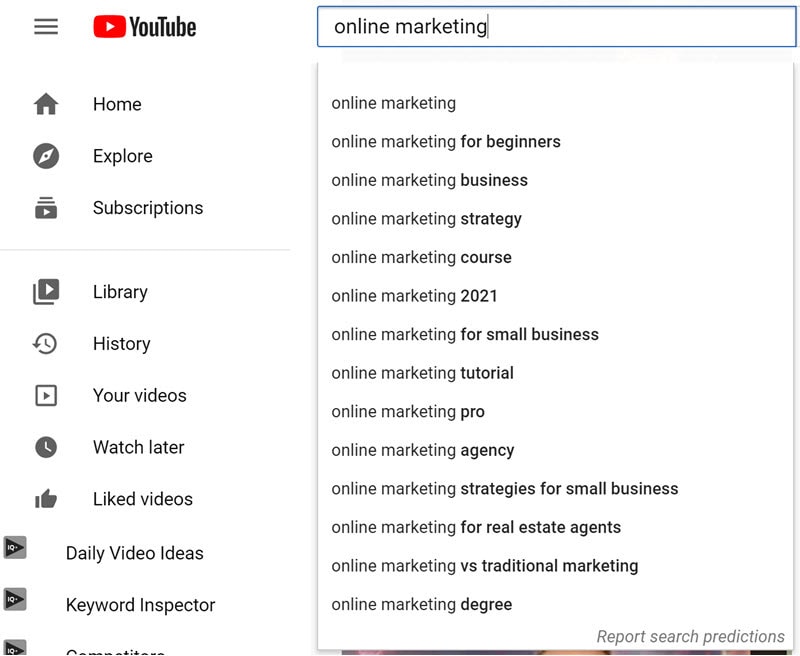
In fact, I’ve put together a step-by-step set of instructions on how to use this and other techniques to generate great content ideas from YouTube here.
Now, of course, this is a different list. Why? Because this is what people are searching for on YouTube, not Google. In other words, this is what they want to watch videos about, while Google is what they want to know about, probably by reading about it.
And it works on Amazon.com:
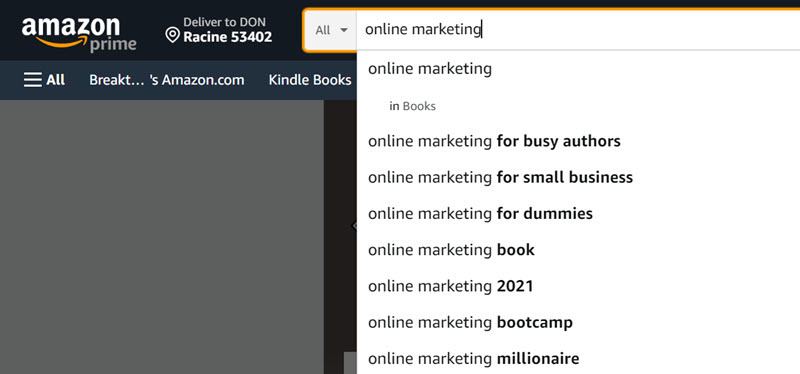
It works on Pinterest:
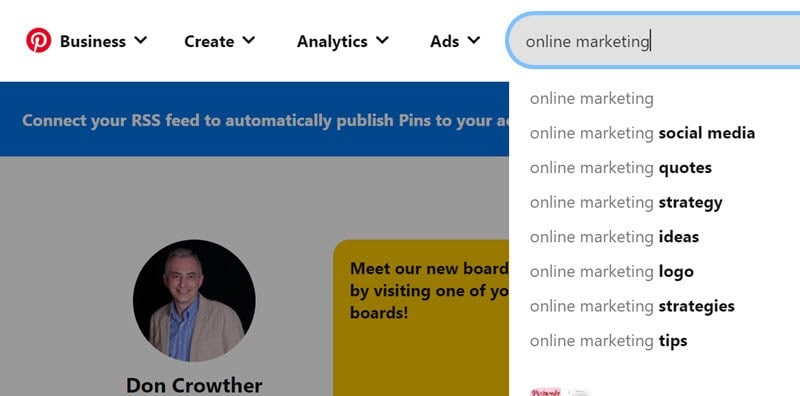
It works on Quora:

It works to some extent on Facebook (though it tends to show group and page names rather than topics:)
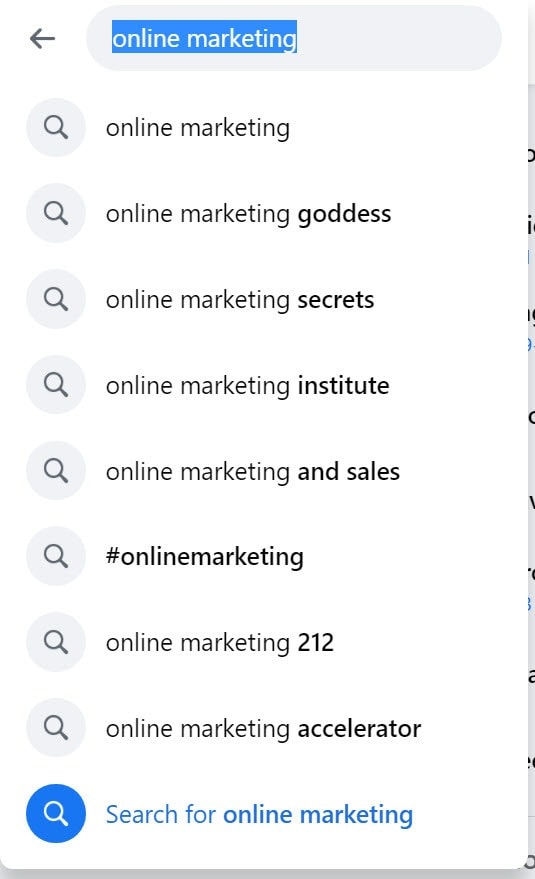
And it works on Etsy:

Though in this case, people aren’t searching for online marketing on Etsy (good to know.) Try typing in “planner” and let’s see what happens:

Once you’ve done these exercises and have a significant list of great content ideas, it’s time to validate which ones are getting the most searches.
There are lots of services you can use to generate and validate content ideas that aren’t free (other than a limited trial) that you can use to validate the number of searches and the competitiveness of the terms you source from the process I just outlined. My favorites are SemRush.com, AHrefs.com, Ubersuggest.com and Spyfu.com (and I strongly recommend that, if you’re serious about doing business online, you sign up for at least one of these services, probably a couple, I use all 4, capitalizing on each one’s strengths.)
But there is another way to validate your content ideas that is also totally, unlimited-ly free: trends.google.com. The advantage of this service is that the data ties back to the research you’ve already been doing on Google.
We’ll go into lots more detail on Google Trends in another article, but for content idea validation purposes, I suggest you type each of the terms you’re contemplating into the search bar separated by commas, like this:

You can search for up to 5 terms at a time.
For the purpose of calibrating the results, there are three places you should focus on when the results page comes up:
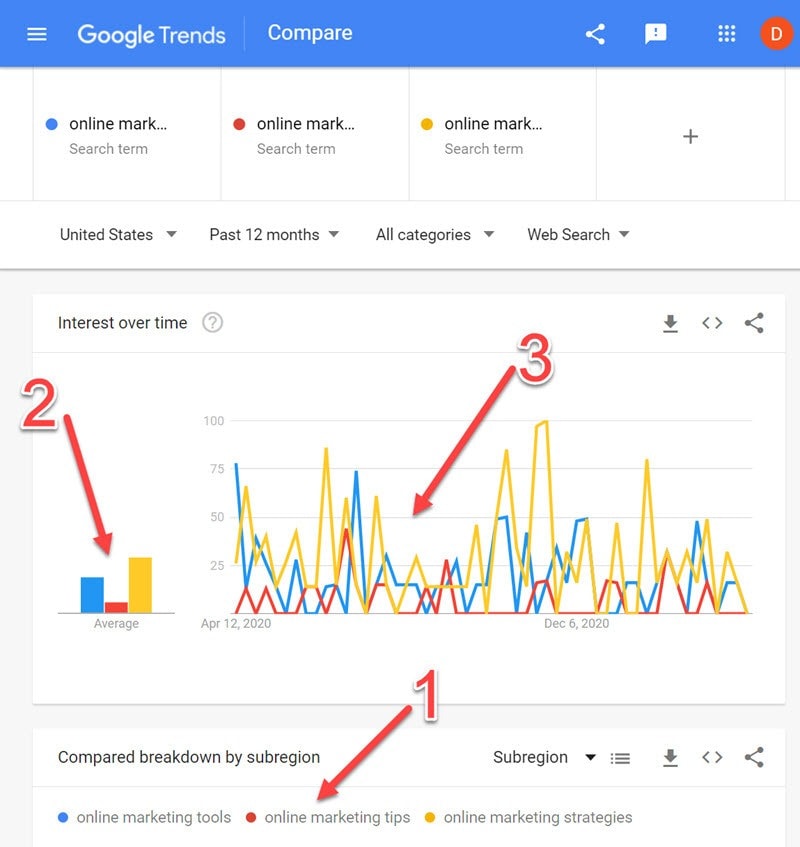
- Since the content idea terms we put in were so long, they don’t fully appear unless your screen is really wide. I like to drop down to the “Compared breakdown by subregion” section to get the key and see which colors represent which term. In this case, blue is online marketing tools, red is online marketing tips and yellow is online marketing strategies.
- The vertical bar graph on the left tells you the relative search volume of each of these three content ideas. If you hover your mouse over each of the bars you’ll see the relative search volume of each like this:
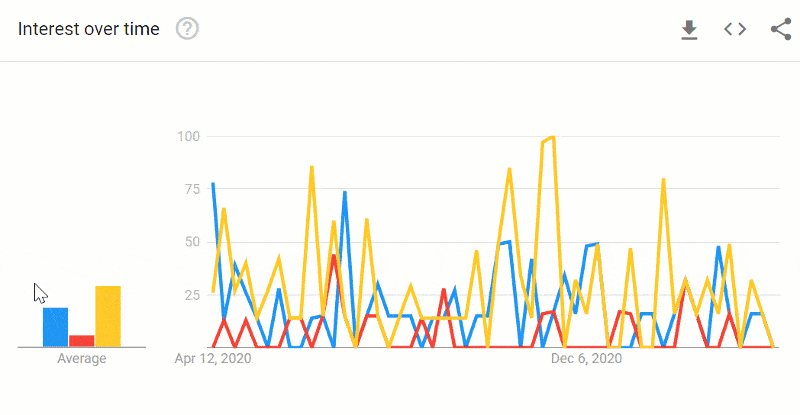
Remember, these numbers are relative to each other. From this data we can tell that online marketing tools is searched for ~3x more often than online marketing tips (19 / 6 = 3.17) and online marketing strategies is searched for ~2.5x more frequently than online marketing tips (50 / 19 = 2.63.)
- The line chart on the right shows you trends for each of these content ideas by giving you visibility into the relative ranking of each term by week. By hovering with your mouse over any of the lines, you’ll see a popup showing the relative search volume of each term for that week:

In this case, since there is no real trend showing up, the lines don’t show us much.
But if you have a trending or seasonal content idea you can learn a great deal. For example, if you do a search on Mother’s Day and Mother’s Day cards in Google trends, you’ll see that the searches for Mother’s Day (the red line) have a couple of small blips during the year, then start in earnest almost 2 months before searches for Mother’s Day Cards (the blue line) even start.
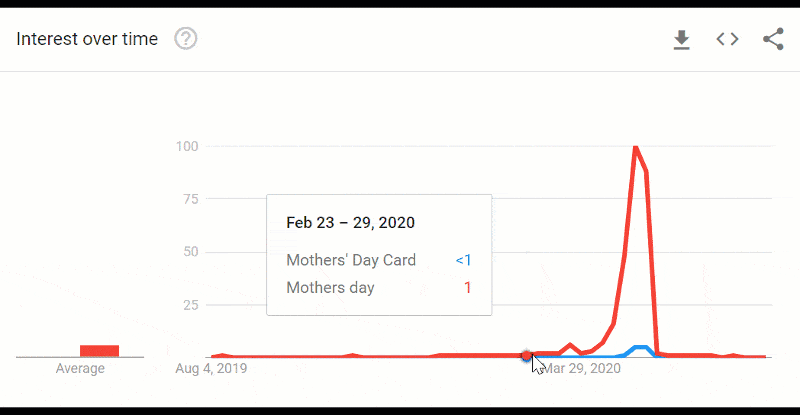
And if you want to geek out on human behavior for a moment notice this comparison between Mother’s Day Gift (the red line) and Mother’s Day Card (the blue line)
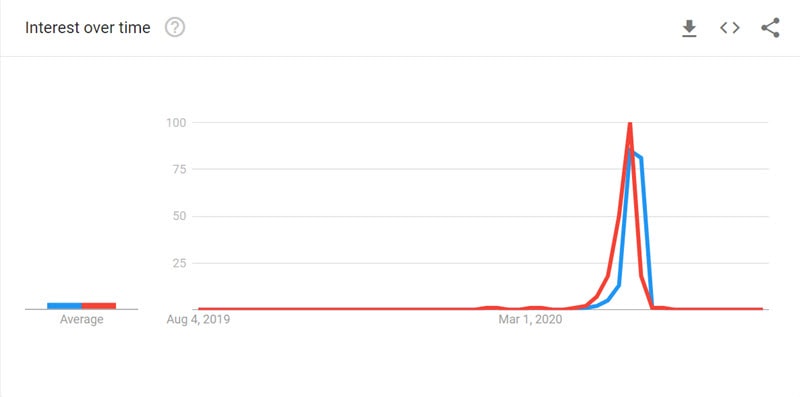
Apparently, those who are committed enough to send mom a gift start searching for gift ideas and finish the process a good 2 weeks before those who just send a card.
How could this apply to you? Let’s imagine that you sell a product that could be given as a mother’s day gift. Without this data you could assume that the prime period to market it would be the 2 weeks just before Mother’s Day. But this data shows that the prime time to market it starts 45 days before Mother’s Day then (somewhat illogically) stops a week or two before the day itself.
Always follow the data any time you’re working to develop content ideas. (Remembering that this data covered the Covid-19 period when most of us had to ship a gift because we couldn’t be there in person, so I just did a quick search over the past 5 years, with the results being approximately the same: start and end your promotions early!
Advanced Tip: Google Trends
Since all the numbers in Google trends are indexed relative to each other within any given search, if you’re going to check multiple different terms, I suggest you do one of two things:
- Always check the top 5 keywords you’ve chosen against each other in a single search to see the relative searches for each one of them.
- Always keep one of the terms the same in all the searches the same, then do some math (a spreadsheet will help) to normalize the indexes so you don’t get confused and think that one term is far more important than another when the opposite is actually true.
An SEO Keyword Mistake I Just Discovered
Finally, let me show you mistake I’ve been making now for 2 and a half decades that I discovered as part of writing this article.
What do you call the title for people who specialize in marketing things through the medium Al Gore so kindly invented for us 🙂 (the Internet)?
- Online marketers
- Internet marketers
- Digital marketers
Looking at this graph of those three terms. One of them is a clear winner. Which term do you think is the yellow line? Online marketer, Internet marketer, or digital marketer?

It turns out that my calling myself either an online marketer or an Internet marketer for the past 25 years has been a mistake. I should have called myself a digital marketer, because that term is searched for ~3.9 times more frequently than online marketer (50 / 13 = 3.85) and 8.3 times more frequently than Internet marketer (50 / 6 = 8.33.)

And just for fun, let’s shift the term from _____ marketer to ____ marketing. The trend continues, with digital marketing beating online marketing by ~2.5 times and Internet marketing by ~6 times.

Oops. I shouldn’t have made that assumption.
Special Note
This article has shown you how to use absolutely free tools to get content ideas for your content marketing efforts.
But, these tools only give you directional indicators as to the best content ideas for you to create content about.
Frankly, there are better tools that give you hard numbers, and can save you lots of time. Like SemRush.com, AHrefs.com, Ubersuggest.com and Spyfu.com, etc.
These free tools will get you started, but I strongly recommend picking up one or two of the paid tools. Not only do they give you precise numbers, the functions I described here are only a small fraction of what you can get from them, and those other tools are invaluable.
It’s up to you, but I’d prefer to pay a relatively small amount of money to get ideas that can make way more than I paid to get that data, with that money coming in every month, for years to come.
Tl:dr: Recommended Lessons To Be Learned And Action Steps
- Always, always, always validate your assumptions before proceeding. Think of this as the online equivalent of measure twice, cut once.
- There is huge mind-expanding value in regularly doing an auto-complete search on the key generic terms people frequently search on in your category to see what specific keywords they use to search beyond that.
- Repeat this process regularly, as needs and searches change, creating opportunities to meet the needs people are searching for right now.
- Doing an alphabet search (example: “online marketing a”, then b, etc.) about once a quarter, to see what other, more specific terms are being searched for, so you can create content to better address peoples’ current needs.
- Dig down deeper into core terms (example: “online marketing tools”) to find other opportunities.
- Do this same strategy on other sites that offer it. YouTube is an absolute must, (here’s a special report showing, in detail, how to do so) but the other tools mentioned here can also provide valuable insights.
- These free methods are great, but there are other, more robust, paid tools that can give you even more information you can use to build your business. I’d seriously think about investing in one or more of them as soon as you can.
How do you intend to use this information to build your business?
This is Don Crowther saying, just go do this stuff.



It’s a terrific strategy, Don. I don’t use the trends feature often, but I use the auto-suggest technique every time. Even though it provides no search numbers, it really helps with coming up with additional phrases and words that I hadn’t thought of. Great to hear from you.
Always keep one of the terms the same in all the searches the same, then do some math (a spreadsheet will help) to normalize the indexes so you don’t get confused and think that one term is far more important than another when the opposite is actually true.
Hi Don,
I’m trying to figure out what this means, how do I apply this?
Thanks
Brett
Great question, Brett.
Here’s the thing. When you do a search on Google Trends, all of the results are relative to each other, not to a single standard. I wish they would just give us the raw information in this tool, but they don’t.
So here’s what you do.
Let’s say you do one search with the following results
Apples 20
Oranges 30
Bananas 50
Then want to do another search for more fruits. In this case, keep apples as one of the terms. The new results may show:
Apples 40
Grapes 30
Pears 20
To get “apples to apples” you’ll need to normalize the data to compare the relative search volumes of the first list versus the second.
In the first list, apples scored 20, in the second 40. That means that you will need to decrease the numbers for each of the items in the second list by half so they can accurately be compared to each other. Thus the total list will now be
Apples 20
Oranges 30
Bananas 50
Grapes 15 (30 * .5)
Pears 10 (20 * .5)
Each additional search you do should also contain apples, then look at the difference between the apples score in that search to the original one, (in this case 20 / 40 = .5) and use that to mathematically convert all the scores in that new batch to match the first list.
I hope that makes sense.
Don
Bloody brilliant Don, love it.
Brett